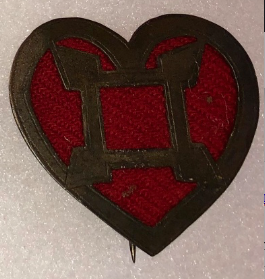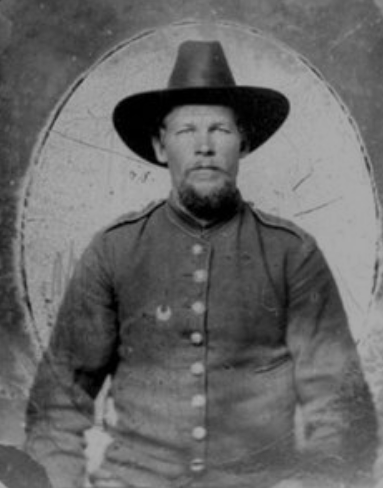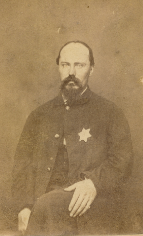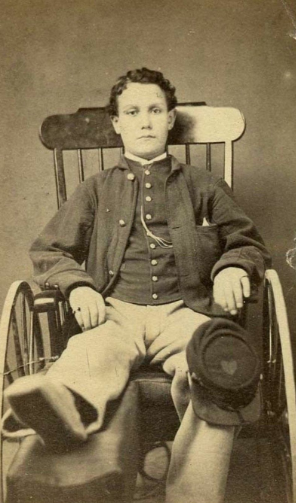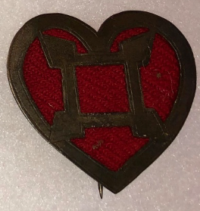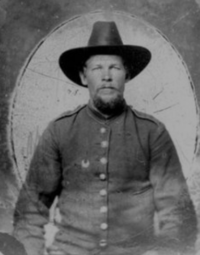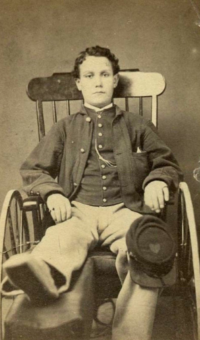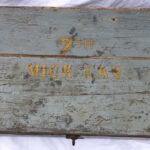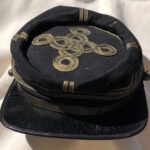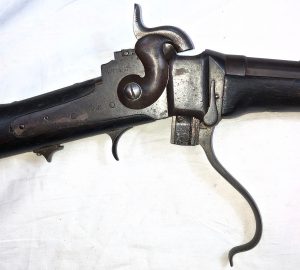Original Civil War Corps Badges – Silver with T-Pins
Original Civil War Corps Badges – Silver with T-Pins – These corps badges are Civil War period and do not appear to be the commonly found veteran badges. All five badges are constructed of silver; four have either enameled or fabric division designations; in addition, all have the war period, T-pin type attachment modes. The badges are as follows:
1 – 23rd Corps, 1st Division – silver shield with red, Kersey wool inside shield; measures: Height – 1.5”; Width – 1.5” – SOLD
XXIII Corps served in the Western Theater as part of the Army of the Ohio.
The corps was organized in April 1863 by order of the departmental commander, Ambrose E. Burnside. Along with Burnside’s old IX Corps, which had been sent west with him after Fredericksburg, it was to maintain a primarily defensive position in Eastern Tennessee and Kentucky. It originally consisted of two divisions under the overall command of General George L. Hartsuff.
The corps played a major role during the Knoxville Campaign, its first major action, distinguishing itself at the battles of Campbell’s Station and Knoxville, and also took part in some minor actions in early 1864. During this time it was commanded by Maj. Gen. Mahlon D. Manson.
The Army of the Ohio joined William T. Sherman for the Atlanta Campaign that spring. IX Corps was detached and sent back to rejoin the Army of the Potomac, so the “army” consisted entirely of XXIII Corps, now commanded by John M. Schofield. It served ably if unspectacularly throughout the campaign.
In the fall of 1864, it was sent north to counter John B. Hood‘s Franklin-Nashville Campaign, and it saw heavy action at the Battle of Franklin, though it was held in reserve at Nashville. After this campaign, the corps was sent east to serve in the Department of the South; it took part in the capture of Fort Fisher and the seizure of Wilmington, North Carolina (the last open port of the South). During this time it was commanded by Maj. Gen. Jacob D. Cox. The corps ultimately joined Sherman’s army in the Carolinas Campaign, and was disbanded in August 1865. (Boatner, Mark M. III, The Civil War Dictionary: Revised Edition, David McKay Company, Inc., 1984)
2 – 11th Corps, 3rd Division – silver crescent with enameled blue field inside the crescent; measures: Height – 1.25”; Width – .75” – $300
XI Corps – On June 26, 1862, President Lincoln ordered that “the troops of the Mountain Department, heretofore under command of General Fremont, shall constitute the First Army Corps, under the command of General Fremont.” The corps thus formed was, for the most part, the same as the one afterwards known as the Eleventh Corps, and within a short time it was officially designated as such. This order of President Lincoln was included in the one constituting Pope’s Army of Virginia, which was formed from the three commands of Fremont, Banks, and McDowell. Fremont’s troops had seen considerable service in Western Virginia, having done some hard fighting at McDowell, and at Cross Keys. General Franz Sigel succeeded to Fremont’s command on June 29, 1862, and was in command at Manassas, where the corps encountered more hard fighting, losing 295 killed, 1,361 wounded, and 431 missing; total, 2,087. At this time the three divisions were commanded by Generals Schenck, Von Steinwehr, and Schurz; there was, also, an independent brigade attached, under command of General Milroy.
By General Orders No. 129, September 12, 1862, its designation was changed to that of the Eleventh, a necessary change, as McDowell’s command had resumed its original title of the First Army Corps. During General McClellan’s Maryland campaign, and during the fall of 1862, the Eleventh Corps remained in Northern Virginia, in front of Washington, occupying various important outposts in the vicinity of Centreville. In December, it marched to Fredericksburg in support of Burnside, but was not present at the battle, after which it went into winter-quarters at Stafford, Va. General Sigel having asked to be relieved, General O. O. Howard was appointed in his place.
General Howard commanded the corps at Chancellorsville, May 1 – 3, 1863, at which time it numbered 12,169 effectives, and was composed of the divisions of Generals Devens, Von ‘Steinwehr, and Schurz. It contained 27 regiments of infantry, of which 13 were German regiments. The men of the Eleventh Corps were good soldiers,– for the most part tried and veteran troops, and were in no way responsible for the disaster which befell them at Chancellorsville. Their commander in that battle allowed himself to be surprised. He was not only surprised, but he had made a very faulty disposition of his troops. The men were not only attacked without a warning shot, but were taken at a terrible disadvantage. Anything beyond a brief resistance was impossible, and they were obliged to abandon their position as any other corps must have done under the same circumstances. Still, some of the brigades changed front under the attack, and made a gallant resistance for over an hour, seriously retarding the enemy’s onset, after which they retired slowly and in good order. The loss of the corps at Chancellorsville was 217 killed, 1,218 wounded, and 972 captured or missing; total, 2,407.
At Gettysburg the corps was still under the command of Howard; the divisions were under Generals Barlow, Steinwehr, and Schurz, and contained 26; regiments of infantry and 5 batteries. It was engaged, in company with the First Corps, in the battle of the first day, and, on the second day, it participated in the gallant defence of Cemetery Hill. On the day before the battle of Gettysburg, the corps reported 10,576 officers and men for duty; its loss in that battle was 368 killed, 1,922 wounded, and 1,511 captured or missing; total, 3,801, out of less than 9,000 engaged.
It accompanied the Army on the return to Virginia after Gettysburg, and, on August 7th, the First Division (Schimmelfennig’s) was permanently detached, having been ordered to Charleston Harbor. On the 24th of September, the Second and Third divisions (Steinwehr’s and Schurz’) were ordered to Tennessee, together with the Twelfth Corps. These two corps, numbering over 20,000 men, were transported, within a week, over 1,200 miles, and placed on the banks of the Tennessee River, at Bridgeport, without an accident or detention.
During the following month, on October 29th, Howard’s two divisions were ordered to the support of the Twelfth Corps, in the midnight battle at Wauhatchie, Tenn. Arriving there, Smith’s Brigade of Steinwehr’s Division charged up a steep hill in the face of the enemy, receiving but not returning the fire, and drove Longstreet’s veterans out of their entrenchments, using the bayonet alone. Some of the regiments in this affair suffered a severe loss, but their extraordinary gallantry won extravagant expressions of praise from various generals, high in rank, including General Grant. A part of the Eleventh Corps was also actively engaged at Missionary Ridge, where it cooperated with Sherman’s forces on the left After this battle it was ordered to East Tennessee for the relief of Knoxville, a campaign whose hardships and privations exceeded anything within the previous experience of the command.
In April, 1864, the two divisions of the Eleventh Corps were broken up and transferred to the newly-formed Twentieth Corps. General Howard was transferred to the command of the Fourth Corps, and, subsequently, was honored by a promotion to the command of the Army of the Tennessee. (FROM FOX’S REGIMENTAL LOSSES CHAPTER VIII)
3. 8th Corps – Silver six pointed star; measures: Height and Width – 1.5” – $375
VIII Corps – The corps was initially created out of various Union commands as part of the Middle Department in the Shenandoah Valley on July 12, 1862, and was placed under the command of Major General John E. Wool. It spent most of 1862 guarding the Baltimore and Ohio Railroad lines between Baltimore, Harpers Ferry, and Winchester. The corps, then led by Robert C. Schenck, played a major role in the early stages of the Gettysburg Campaign, where elements of the corps unsuccessfully opposed Robert E. Lee‘s initial advance through the Shenandoah. The second division, under Robert H. Milroy, suffered heavy casualties during the Second Battle of Winchester on June 13–15, 1863, and elements of the corps also took part in the delaying action at Martinsburg a few days later. The badly battered corps withdrew to Harpers Ferry after that, playing no further role in the campaign, until it helped join in George G. Meade‘s pursuit of Lee following the Battle of Gettysburg.
Defense of Washington and Garrison Duty in 1864 – The VIII Corps played a major part in the defense of Washington from Jubal Early at Monocacy on July 9, 1864 under the commander of Maj. Gen. Lew Wallace. The primary duty of the VIII Corps in 1864 was rear echelon duties in Maryland guarding the Baltimore and Ohio Railroad. Elements of the corps also battled Confederate cavalry as it raided across Maryland to the suburbs of Baltimore during Early’s Raid on Washington. The headquarters of the department was located in Baltimore.
Army of West Virginia – The VIII Corps is often confused with the Army of West Virginia which served in the Shenandoah Valley and western Virginia throughout 1864. This confusion stems from the Army of West Virginia being composed of troops that had served in the Eighth Corps in 1863 but were officially transferred to the Department of West Virginia by the time of the 1864 Campaigns. It is furthermore confusing in the fact that the Army of West Virginia functioned as a corps within the Army of the Shenandoah. The result was references to the Army of West Virginia as the VIII Corps even though they were never officially synonymous. (Eicher, John H., & Eicher, David J., Civil War High Commands, Stanford University Press, 2001)
4. 18th Corps, 4th Division – silver cross with trifoliate arms; yellow enameled face; measures: Height and Width – 1.75” – $325
XVIII Corps – The XVIII Corps was created on December 24, 1862. It was initially composed of five divisions stationed in North Carolina, making it one of the largest in the Union Army (though two were detached to join the X Corps in early 1863), and placed under the command of General John G. Foster. By August 1863, most of the corps’ original units were either disbanded or transferred elsewhere, but Brig. Gen. George W. Getty‘s division (formerly of IX Corps) and the bulk of the recently discontinued VII Corps from Virginia were re-designated the XVIII Corps.
During the spring of 1864, the corps—now commanded by General William Farrar Smith, formerly of VI Corps—was transferred to Yorktown, Virginia, to join Maj. Gen. Benjamin Butler‘s Army of the James. The corps played a major part in the unsuccessful operations in the Bermuda Hundred, and was also heavily engaged at Cold Harbor. On June 12, Lt. Gen. Ulysses S. Grant sent Smith on a surprise march to seize Petersburg from the Confederate forces before Robert E. Lee could bring up the bulk of the Army of Northern Virginia. In the Second Battle of Petersburg, June 15-18, 1864, Smith made successful initial attacks against the outnumbered defenses of Gen. P.G.T. Beauregard; but after driving Beauregard’s men from their outer entrenchments on the 15th, Smith, fearful of a Confederate counterattack, lost his nerve and did not press the attack when it could have resulted in the easy seizure of the city.
Smith was relieved of command in July due to ill health, and he was replaced by Edward O.C. Ord and later Godfrey Weitzel. Charles A. Heckman briefly commanded the corps following the wounding of General Ord during the Battle of Chaffin’s Farm. John Gibbon was temporary commander of the corps in the month of September 1864. The corps occupied the line of entrenchments closest to the main Confederate line, and suffered heavy casualties in almost daily skirmishing for a month. The corps was relieved of its position by X Corps on August 26, and the corps was sent first to the Bermuda Hundred, and later to the north bank of the James River. Its first division took part in the successful attack on Fort Harrison on August 29 during the Battle of Chaffin’s Farm. The corps was also engaged on October 27 in the Second Battle of Fair Oaks, fought over the same ground as the first battle in May 1862. The corps was ultimately discontinued in December 1864; as with X Corps, its white units went to join the new XXIV Corps, while its black units joined XXV Corps. (“Regimental Losses in the American Civil War (1861-1865)” – William F. Fox)
5. 10th Corps inside 24th Corps, 1st Division; silver with red kersey weave wool on the face; measures: Height – 1.75” Width – 1.75” – $450
X Corps – The corps was officially created on September 13, 1862, to consist of the majority of Union troops operating in South Carolina and eastern Georgia. In December 1864, the corps was disbanded; its white contingent went to the new XXIV Corps, while its black units went to the XXV Corps. The corps took part in most of the operations against Charleston from 1862–63, including attacks on James Island and Morris Island and the Battle of Fort Wagner. Other elements of the corps based in Florida took part in the disastrous Battle of Olustee.In early 1864, the corps, now commanded by Gillmore, was transferred to the Army of the James. It took part in the Bermuda Hundred operations and played a principal role in the disastrous Drewry’s Bluff action. It also took part in the attack on Cold Harbor in conjunction with units of the Army of the Potomac, and the corps played a major role in the early stages of the Petersburg Campaign.
